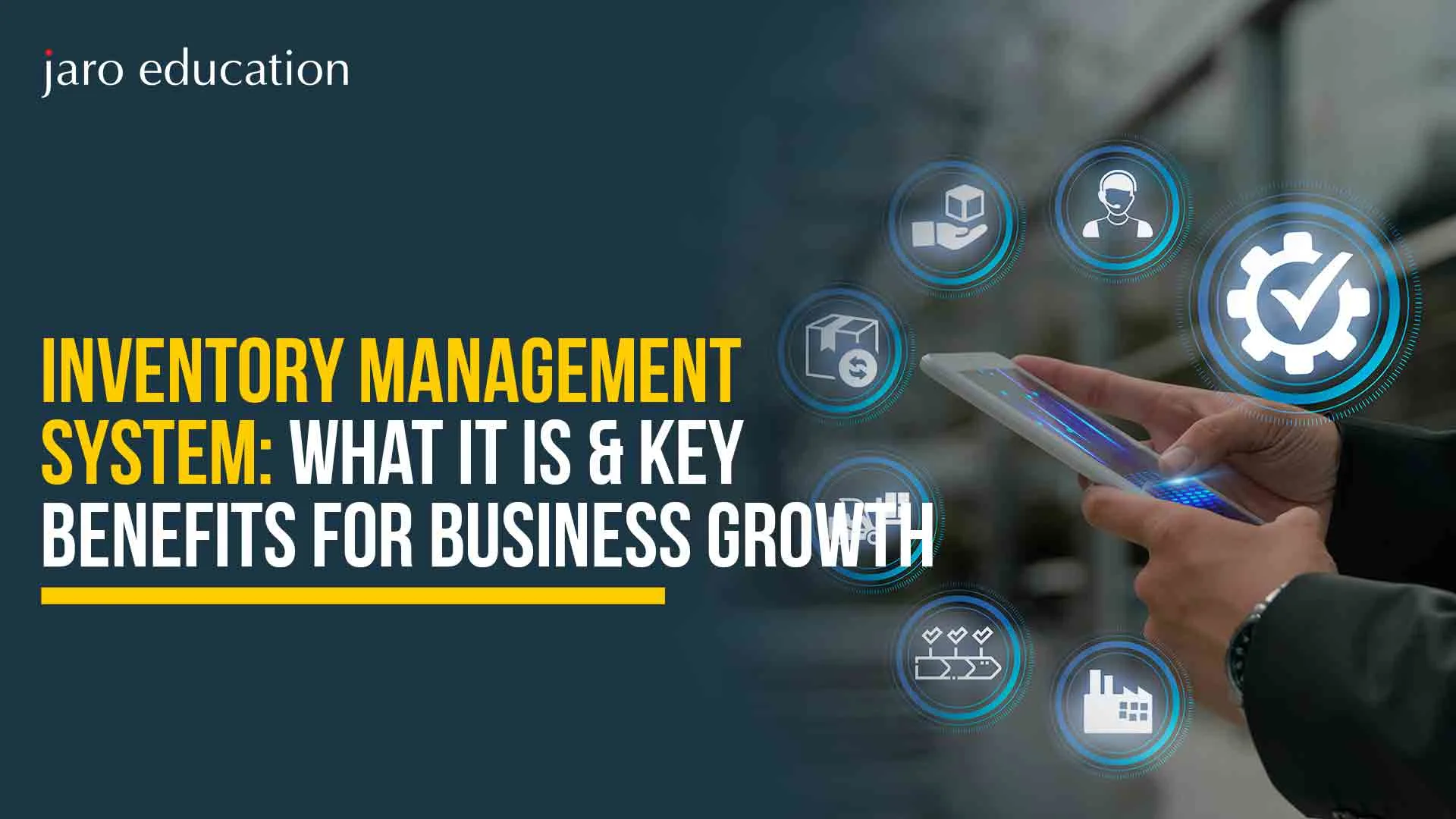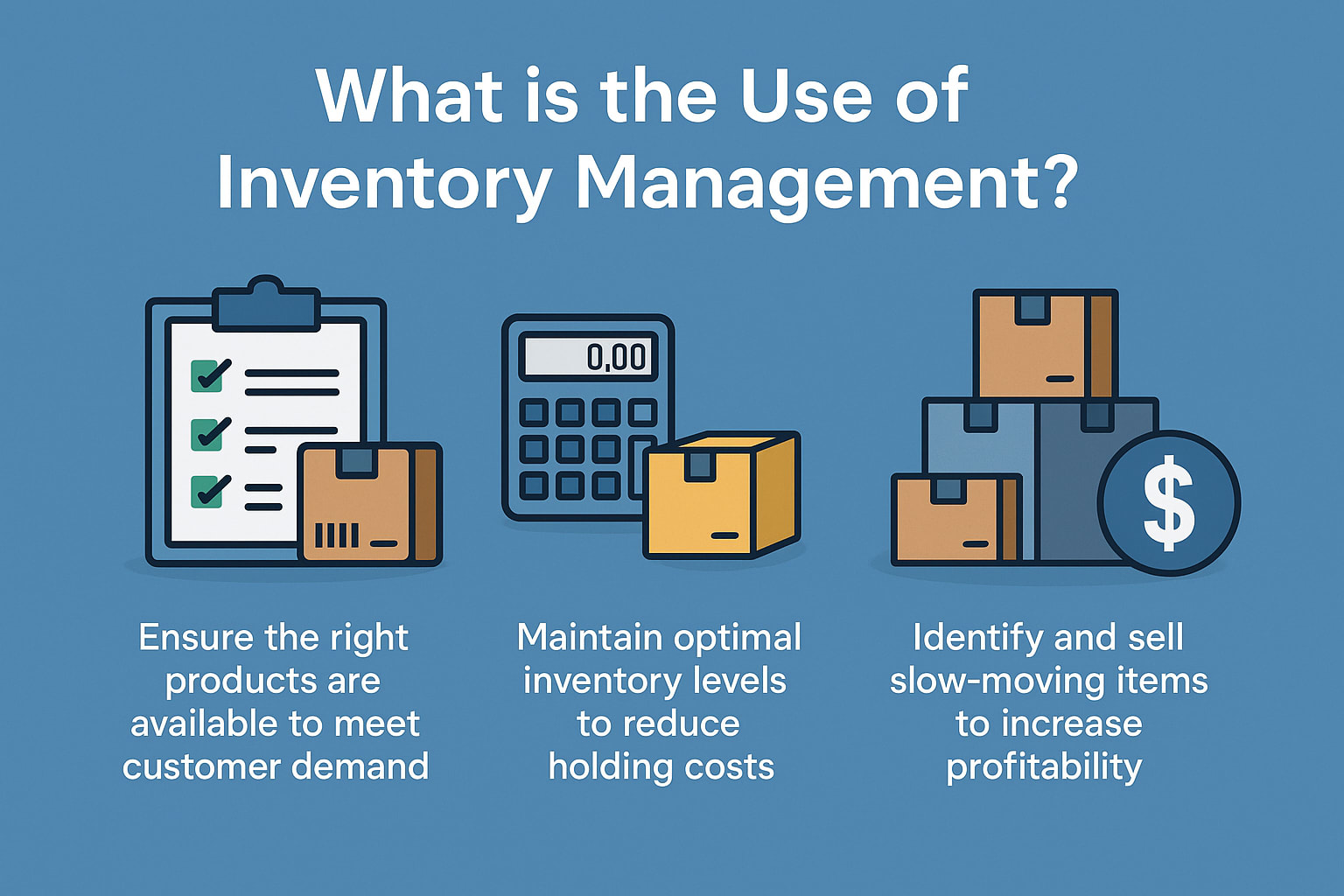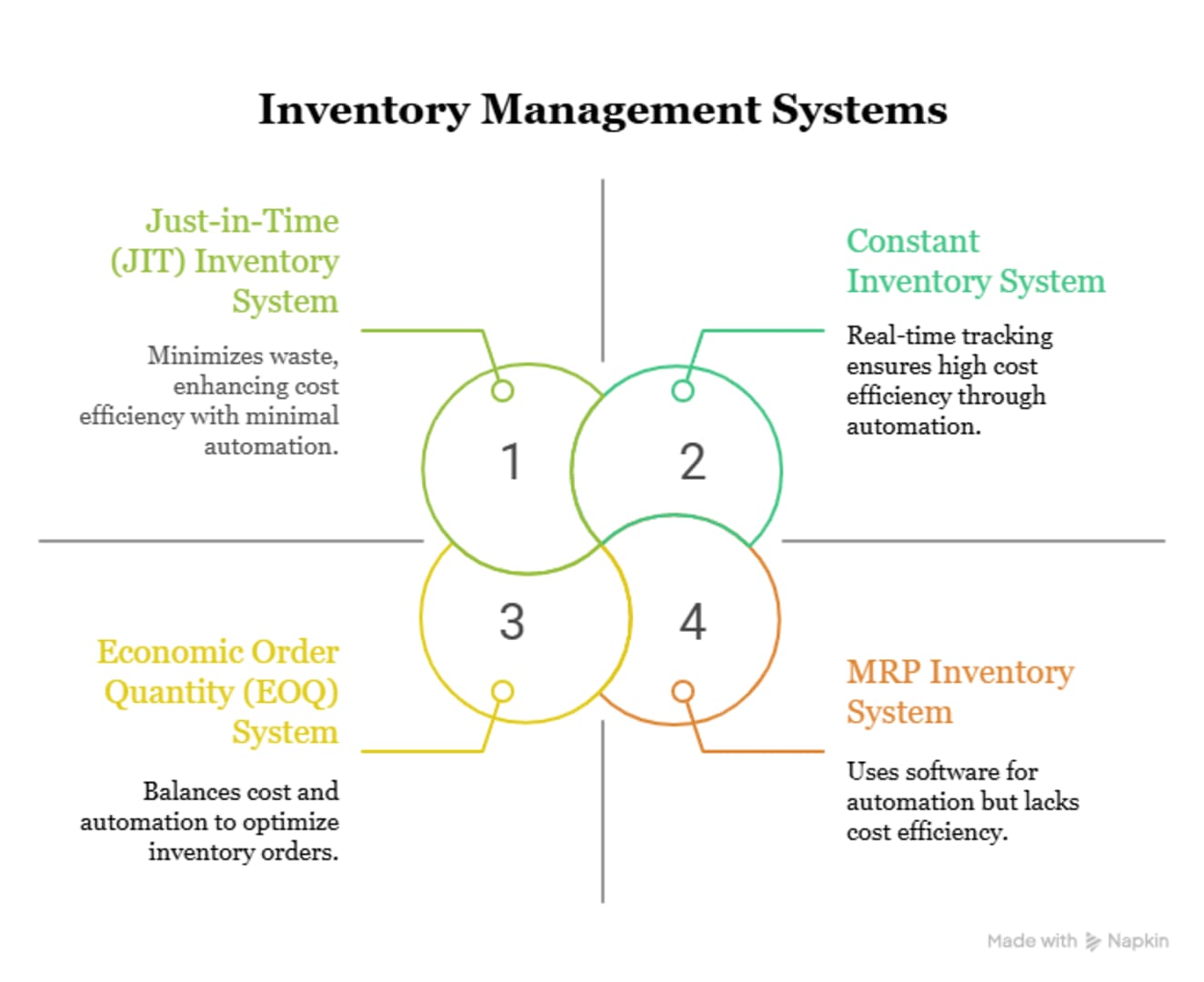Inventory Management System: What It Is & Key Benefits for Business Growth
Table of Contents

- jaro Education
- 3, October 2024
- 5:00 pm
In a competitive environment, where customer expectations are high, having total inventory control is a make-or-break situation. A poor inventory management system silently eats away at profits and frustrates customers by preventing them from buying goods due to out-of-stock and piled-up inventory. However, what would happen if there were a smarter way to do it?
Find out how a well-designed inventory management system can lead to reductions in cost, increases in profits, and the satisfaction of your customers. As the market for inventory management software in India is estimated to grow to 401.72 billion in 2032, there is no doubt that corporations are finally realizing the strength of online inventory management.
In this blog, we will talk about why an inventory management system is more important than ever and how it can make a difference to your bottom line, and which tools and practices can guide you in the future to be on top of the game. Rather than the choice to make or break your business, as it was in the past, now inventory control is something you need to know how to do well with whichever business you run, whether it is a retail store, a warehouse, or an online business.
What is an Inventory Management System?
The inventory management system involves the process of managing and streamlining the process of placing orders, storing, selling, and restocking the products/services of a company. It deals with the deliquescing of the raw materials and parts, the work-in-progress products, and the selling of the finished products. The objective of inventory management is to make sure that the company possesses the correct inventory at the correct moment to satisfy the needs of the customer and reduce the amount spent on holding and ordering.
What is the Use of Inventory Management?
It is obvious that the contention behind inventory management is more than a mechanism of monitoring the stocks. The daily operational issues contain a larger scope. At the strategic level, inventory management may:
- Make sure the firm possesses the appropriate products in order to satisfy the demand on the part of customers without stockouts.
- The inventory should be set at an optimum level; this reduces the holding costs and increases cash flow.
- Pick the old or slow-moving stock that can be realized to decongest the storage areas. In essence, goals, objectives, and the value statement of inventory management will be based on the objectives of the business.
As an example, we will assume that the largest business goal at hand is to enhance profitability.

Here is how inventory management can be useful in this regard:
- Minimizing and/or reducing the cost of holding inventories through maintaining desirable levels of stocks and minimizing the holding of unnecessary stocks.
- Reducing the chances of stock-outs and missed sales through the availability of the right products at all times.
- Increasing inventory turnover and cash collection by finding and disposing of slow or obsolete inventory.
Key Benefits of Inventory Management System
The benefits of an inventory management system are many; these include reduced holding costs, better cash flow, better inventory management leading to customer satisfaction, and better decision-making.
Among the everyday advantages that inventory control brings about, we have noted the following:
- Streamlining inventory level
Proper management of inventory also enables companies to keep the best stocks that are supported by the demand estimations and lead times. This will guarantee that you make adequate stocks to satisfy the customers without excessive investment in unnecessary inventory. Optimization of the inventory can result in an effective reduction of the holding costs and cash flow.
- Preventing stockouts
It is a nightmare for every retailer to run out of stock. It results in lost sales, frustrated clients, and a ruined brand image. Inventory management will also help prevent stockouts, since you will have an idea of the amount of stock quantity available at all times, have reorder points, and practice timely replenishment. Having the right products in stock at all times offers you a chance of maintaining happy and loyal customers.
- Enhancing fulfillment of orders
In the current world, customers demand instant and precise order processing. Inventory management is very important in simplifying your order fulfillment operation. Having real-time information on which product is in which location, you can fast-track picking, packing, and delivering orders with less turnaround. A great customer experience lies in how well inventory is managed.
- Decreasing dead stock
Dead stock labels items that are lying on your shelves and that have not been sold for a long period. This may wind up as a result of a lack of good demand forecasting, a change in customer tastes, or seasonal variations. Dead inventory uses up the working capital and storage area. Inventory management will assist you to be able to identifying the slow-moving commodities so that you can proceed to run promotions with them or bundle the commodities to get rid of the stagnant stock.
Inventory Management Challenges
The inventory management obstacles that organizations face are having surplus inventory that can not be sold, having product shortages in fulfilling incoming orders, and not being accurate with inventory tracking. Other obstacles to inventory management include the following:
- Poor or outdated processes and overall inventory management systems
- Fluctuating consumer demand as they change their needs and desires
- Difficulty navigating a warehouse to find certain products
Types of Inventory Management

1. Constant Inventory System
A perpetual inventory management system of maintaining a real-time inventory. This system has an automatic feed on the number of products left on the shelf, the number of products sold, and the balance of products. Such a system applies well in businesses that have many items to handle since it avoids overstocking and understocking.
2. Just-in-Time (JIT) Inventory System
Just-in-time inventory management system is one way of managing inventory that works to minimize waste and enhance efficiency. In this system, suppliers will be required to deliver products only on a need basis. The manufacturing industry widely uses this system because it assists in cutting down the inventory held and the costs involved.
3. Economic Order Quantity (EOQ) System
Economic order quantity inventory management system is an inventory management system that is intended to reduce the total inventory cost of an enterprise. This system determines the most appropriate inventory to order depending on the cost of ordering and holding inventory, demand, and lead time.
4. MRP inventory system
Material requirements planning inventory system is a system of inventory management that is based on the usage of computer software to plan and control production and inventories. The factors that are considered in this system include demand, production capacity, and inventory to make certain that the right amount of inventory is present at all times.
Tips for Better Inventory Management
Picture a business located in a place that does not have effective methods of inventory management or controlling an inventory management system, since it will directly affect profitability, cash flow, and customer satisfaction. Optimization of inventory enables businesses to overcome stockout situations, minimize holding costs, and increase operational efficiency across the board.
The following are some of the main tips for the improvement of inventory management provided by experts:
- Effective estimation of demand
Demand Forecasting is the estimation of the product or service and requires the estimation of the requirements of the customers in the future.
Efficient predictions will also aid in bettering the inventory, thus avoiding stockouts and overstocking.
Use previous sales, market trends, promotional programs, and other related resources to support your forecast.
Use both quantitative and qualitative analysis, time series analysis, and causal forecasting in addition to market research and the opinion of the experts.
Revise your forecasts regularly to correct them based on new information and new market conditions.
- Install inventory management software.
Real-time inventory management software gives accessible involvement in the stock status of all sites and collects all information in one section, reducing the number of procedures.
They can automate activities such as reordering, tracking, and reporting, which minimizes errors due to manpower and increases efficiency.
Steam solutions can assist businesses in making data-driven decisions regarding the inventory and monitoring the main metrics, such as the inventory turnover.
Features to consider include real-time monitoring, forecasting, and generation; purchase orders; barcode scanning; and integration with your point-of-sale (POS) systems or eCommerce platforms.
- Optimise warehouse activities
A well-designed warehouse in which there are specific sections to receive goods, store, pick up, and pack can be very efficient.
Study the space better by making use of vertical and horizontal storage with clear movements.
Label items, shelves, and bins with clear systems via SKUs (Stock Keeping Units) and barcodes to be able to track items faster and more accurately.
The processes in the warehouse can further be automated through technologies such as robotic picking and packing systems, which reduce errors too.
- Inventory methods: Strategic strategies
First-In, First-Out (FIFO): This inventory management method helps older products be sold first, which is extremely necessary in the case of perishable or time-sensitive inventory items, to dispose of excess inventory to prevent wastage and obsolescence.
Just-in-Time (JIT) Inventory: Holding costs should be reduced to the minimum, and to do it, preparation of proper forecasts and reliable suppliers are necessary.
ABC Analysis: divides inventory into A (high-value, low volume), B (moderate), and C (low-value, high volume) items, which then follow the ranking of management effort according to their priority.
Safety Stock and Reorder Points: In case of unforeseen developments in terms of an influx of demand or supply-related issues, make sure that a certain safety stock will save you against stockouts. Put reorder points so as to order new sets before they get to extremely low stocks.
- Minimize shrinkage in inventory. Reduce theft of inventory
Theft, damage, or administrative errors that cause shrinkage affect profitability.
Ensure the usage of automated inventory management software to help eliminate human errors and track the movements of the inventory.
Put in place security protocols such as theft prevention devices through CCTV cameras, barriers, and checkups.
Train the workers on how to handle inventory and what to do in terms of security.
Improve inventory turnover to minimize the chances of goods getting lost or damaged as they lie in store.
- Develop great relationships with suppliers
Stable suppliers are essential in ensuring the effective flow of inventory and the supply chain.
Provide frequent communication with the suppliers to agree on the forecasts, offer agreeable terms, and eliminate or deal with possible interference before it occurs.
Think of diversifying your supplier and thereby reducing risks when dealing with a single supplier.
- The data-based decision-making
Perform periodic reviews of your inventory statistics, such as turnover rates, stockouts, and cost of holding inventories, to see any trends and areas where improvement can be made.
Run reports and dashboards with inventory management software to give you nice insights into how your inventory is performing.
Based on the data, make accurate decisions regarding purchase, price, and promotions to maximize inventories and also make better profits.
- Within constant appraisal and modification
Inventory management is not for people who should act quietly and not get noticed.
Periodically check what you are doing, get input from employees and customers, and approach current business needs and market conditions.
By following these suggestions and relying on the possibilities of technology, companies can truly improve their efficiency in managing their inventory, cut down considerably on their business processes, and become much more successful.
How to Choose the Right Inventory Management Software?
Choosing an inventory management software can be a big decision for your business. The right software can save you time, reduce mistakes, and allow you to grow your business. With so many options out there, how are you reasonably expected to choose the right inventory management software for your business?
Here is a step-by-step guide with more general language:
1. Consider your Business Needs
Before downloading or purchasing any software, think about your business first.
Do you sell products online, in-store, or in both locations?
Is this one location, or do you have multiple locations?
Do you have many products or only a few in your product selection?
Does your business require expiration dates or even batch tracking?
Why does this matter? Some inventory management software may be suitable for a small shop, while other software provides tools suited for large, multiple-location businesses.
2. Check Features For Ease Of Use
Software should be easy, and it should make sense even if you know nothing about computers or inventory management software.
Look for features like:
- Livestock levels reporting
- Alerts for when stock items are low
- Ability to scan bar codes
- Automatic reordering
- Sales and inventory reporting
Why does this matter? If the software is easy to use, then your team’s time will be saved and mistakes eliminated.
3. Check for Integration with Other Tools
Does the software connect with other systems you use already?
For example:
- Your accounting system (like Tally or QuickBooks)
- Your e-commerce system (like Shopify or Amazon)
- Your billing or POS system
Why it matters: Integration means you have the most up-to-date data everywhere and don’t have to input that data over and over again.
4. Make Sure It Can Grow
Your business will expand, so your software should also expand.
Ask yourself questions like:
- Will I be able to add more users or locations down the road?
- In the future, will the system accept more orders/products?
Why it matters: You don’t want to have to transition to a new software after a year, because you can’t scale to your growth.
5. Check for Customization
Some businesses have special requirements. An effective inventory software should allow you to be able to:
- Define your stock categories
- Generate custom reports
- Create reorder rules based on each product
Why it matters: Custom features will allow you to manage your inventory your way, rather than just the system’s default way.
6. Review Pricing Plans
Review what each plan gives you, what the cost is.
Does the free version give you everything you need? Are there hidden fees? What is included in the monthly plan (support, updates, training)?
Why it matters: You want to select software that meets your current budget but can also scale with you with little extra cost down the road.
7. Test Software Before You Buy
Many companies offer free trials or free demos. Take advantage and:
- Try the features
- Test speed and reliability
- Get feedback from your team
Why it matters: Nothing beats real experience using the software and making an informed decision.
8. Review Support and Training
Even the best software has issues from time to time.
Think about:
- 24/7 customer support (chat, email, phone)
- Training videos or user guides
- Onboarding support to get you started
Why it matters: Having good support will help resolve issues faster, so you can keep your business running smoothly.
Mastering Inventory Through Education
Mastering inventory management is crucial not only for retail or manufacturing sectors but also for industries like education, where managing resources such as digital content, course materials, and student data is essential. Just as a scalable and user-friendly inventory management system supports business growth, acquiring the right education helps professionals develop essential leadership, strategic, and operational skills that drive success in managing complex business environments.
Enhancing expertise and advancing careers becomes easier with the Executive Programme in Operations Management and Analytics Programme offered by the Continuing Education Programme (CEP), IIT Delhi. This program provides cutting-edge knowledge in business strategy, leadership, and advanced management practices, equipping professionals with the tools needed to make informed decisions in today’s dynamic industries.
Explore CEP, IIT Delhi to take a strategic step toward professional growth, just as a well-managed inventory system helps businesses thrive.
Jaro Education: Your Guide to Smarter Career and Education Choices
For over 16 years, Jaro Education has been supporting working professionals and students in making informed decisions about their careers and education. Our expert career counselling and global partnerships with leading institutes (like IITs, Speakers, IIMs, and international universities) allow Jaro Education to offer programs that align with your goals and industry requirements, motivating our education and career turnaround. Jaro Education will be your best ally, regardless of your intention to reskill, switch careers, or step into a leadership role or corporate role. In doing so, we give the information on proven data and insights for over 350,000 successful alumni and a program completion rate of 82%. Jaro Education is a trusted career partner for thousands of others across India.
Conclusion
Mastering inventory management is essential for any business aiming to cut costs, improve efficiency, and keep customers satisfied. By implementing a reliable inventory management system and using tools for inventory monitoring, you can gain greater control over your stock, make smarter decisions, and support your business’s growth.
Start optimizing your inventory management practices today to unlock these benefits and elevate your business to the next level.
Frequently Asked Questions
The best inventory management software for small businesses depends on your needs, but popular options include Zoho Inventory, QuickBooks Commerce, and Square for Retail. These tools offer easy-to-use interfaces, real-time tracking, and affordable pricing for small-scale operations.
Real-time inventory management keeps your stock data updated instantly, helping you track items as they’re sold or received. This helps prevent stockouts by alerting you when products run low, so you can reorder before running out.
Inventory management is crucial for e-commerce because it ensures products are available for customers when needed. It reduces order delays, prevents overselling, and improves customer satisfaction, which leads to repeat purchases and higher ratings.
An inventory monitoring system tracks item movement, stock levels, and shelf life in real time. This improves warehouse efficiency by reducing manual work, preventing misplaced stock, and ensuring faster order fulfillment.
For retail stores, look for features like barcode scanning, POS integration, low stock alerts, real-time reporting, and multi-location management. These features help streamline operations and improve inventory accuracy.
Manual systems use spreadsheets and physical counts, which are time-consuming and error-prone. Automated systems use software, barcodes, or RFID to update stock data in real time, improving accuracy and efficiency.
Many inventory tools integrate with accounting software like Tally, QuickBooks, or Zoho Books to sync sales, purchases, and stock values. This helps maintain accurate financial records and simplifies tax reporting.
Inventory software helps reduce overstocking, prevents expired or unsold items, lowers storage costs, and optimizes purchasing. These improvements lead to better cash flow and reduced waste.
Yes, many advanced inventory systems support multi-location tracking. You can monitor stock levels across different stores or warehouses from a single dashboard, making restocking and transfers easier.
Without proper inventory management, businesses may face issues like stockouts, excess inventory, poor customer experience, inaccurate financial reports, and lost sales opportunities.










